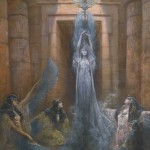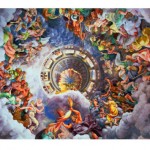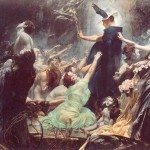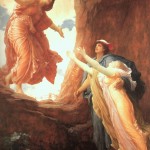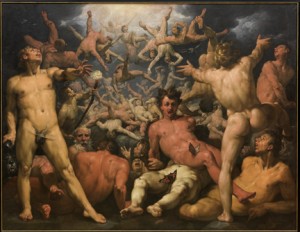 I’ve been noting over that past year the use of the term monist to designate a bad kind of paganism, at least from the point of the writer, particularly when they are of the so-called “hard” polytheist variety (recent example). Frankly, I’m never really sure what they mean other than monism is some how bad. It’s use also (apparently) contradicts the technical meaning of the term. Perhaps you help me understand how they mean to use it…
I’ve been noting over that past year the use of the term monist to designate a bad kind of paganism, at least from the point of the writer, particularly when they are of the so-called “hard” polytheist variety (recent example). Frankly, I’m never really sure what they mean other than monism is some how bad. It’s use also (apparently) contradicts the technical meaning of the term. Perhaps you help me understand how they mean to use it…
There is an interesting contrast in how certain folks, generally self-described hard polytheists, make between themselves and some set of folks called monists. The hard-poly position seems to be, per Wikipedia, “the belief that gods are distinct, separate, real divine beings not psychological archetypes or personifications of natural forces. Hard polytheists reject the idea that “all gods are one god.”…This is contrasted with “soft” polytheism, which holds that gods may be aspects of only one god, psychological archetypes or personifications of natural forces.” I think this contrasting ‘soft’ definition is what some folks think of as monism. But, really?
Monism, as it appears in human history, has a significantly different framing. There has been a lot of good reason on this subject and some bad. My favorite is Thomas McEvilley’s The Shape of Ancient Thought, which is a real page turner for Pagans as it covers the historical origins of most of the ideas that constitute contemporary Pagan thought. One of the more problematic works is Athanassiadi & Frede’s Pagan Monotheism in Late Antiquity, which tries to turn ancient Greeks and others into monotheists, as though that was a good thing. I think their main problem is they are ignoring the theological definition of monotheism, namely that it is exclusivist, and conflating it with monism. How unfortunate.
Monism shows up, where we can see it, first in Ancient Old Kingdom Egypt, then in Mesopotamia and in India as well. It is formed around that idea that all the Gods are parts of the ruling God, at first Atum and later Ptah in Egypt, or where the whole world becomes attributes of a particular God, such as Inanna in Mesopotamia about 2000 BC [McEvilley, p. 24ff]. But before we dive into the myth too deeply, we need to understand the state of thought in the period. Philosophy, the rational discursive explication of the world had not developed yet (soon!), and so the way of describing the world at this most ancient time was through narrative. The myths we have are the remaining products of this effort and kind of speech. But to understand them we have to understand the problem they were trying to solve. Indeed it can be suggested that this very problem led to the formation of philosophy as it burst the bounds of narrative to express the understanding embodied in the myths.
Put discursively, monism is rooted in the intuition that “All is One”. The problem is that while unity is intuited, we also directly perceive the many-ness of the world. As a position, this many-ness is called dualism, and had many proponents in the ancient world, such as Democritus, the Atomist. The debate between these positions is apparently quite ancient and was arguably the most important philosophical problem in the ancient world. Later, and up to today, the problem became and remains, “How would we know anyway?”
One of the forms of monism most influential on today’s thought comes from Parmenides of Elea, who in formulating what we now consider the ‘laws of thought’ in formal logic, mostly known from Aristotle, produced an understanding of the world in which “change is impossible, and existence is timeless, uniform, necessary, and unchanging.” This is contrasted to “the world of appearances, in which one’s sensory faculties lead to conceptions which are false and deceitful.” There have been a variety of formulations of this idea, one of the most famous being the Hindu concept of maya, in which the senses tell us only illusion. Needless to say these two positions are hard to reconcile, but that difficulty mostly come from the way we reason.
As mentioned, Parmenides gave us the Laws of Thought, namely the Laws of Identity, Excluded Middle and Non-Contradiction. It is this last one that is giving us trouble here. Are the Gods One or are the Gods Many? Actually, the real question is whether existence is a unity or a plurality, but we should not lose sight of the problem our community is wrestling with. Per the laws of thought, it has to be one or the other, One or Many, or be stuck in a logical contradiction. And there’s the rub…
The problems of monism and dualism travel along with two others, eternalism, alluded to in Parmenides’ formulation, and nihilism which in its most extreme forms simply denies reality’s existence. These four positions were taken up by the great Indian philosopher Nagarjuna and, apparently using a primer of Greek logic, pointed out the logical consistency of each position and their utter mutual contradiction. It was his genius that realized the problem this poses is created by the limitations of logic and discursive expression. From this he formulated the Madhyamaka or “Middle Way”, the way that lies between the contradictions of monism, dualism, eternalism, and nihilism, which can be directly experienced through meditation but not through rational discourse because, in part, it breaks the law of non-contradiction. The Middle Way recognizes the truth in each position, but reckons each of them incomplete.
So, back to our problem. Are the hard polytheists right or are the so-called soft polytheists? For me, the problem between the two comes from staking out contradictory positions. Perhaps there is a motivation of identity formation here, but the parties will have to speak for themselves. What I see is a lack of philosophical depth to realize that things that are logically contradictory in ordinary thought, at the Divine or noetic level are complementary.
And before someone goes off saying, “But I experience the Gods as real separate existent Beings!” or another saying how impossible that is, I have a crucial question for you: Are you really trying to limit how the Gods appear to us? Are you really saying that the Gods lack the ability to appear as aspect of our psyches or as separate existent even anthropomorphic Beings? If so, I’m not sure you are talking about Deities. What makes a Deity not a Superhero is that they are a manifestation or embodiment of the structures of existence, otherwise they would just be really powerful beings like Marvel Comics’ Thor. Truly Divine Beings show up however They like, usually how we need to experience them, moderated by how ready we are to receive them.
My problem with this conflict or contrast between hard and soft polytheism is that the proponants seem to think it has to be one or the other. Seriously? Do you have so limited experience of the Gods that you would limit Them so? Is it not possible that one person experiences a theophany complete with vision of an anthropomorphic Deity with, say, full retinue, symbolic attributes, proper dress and gender and all that, while another experiences just as truly that same Deity manifest as a power in her Soul, while a third meets that Deity in Nature as some aspect of Its Power and Glory? What makes a Deity a Deity is that It can be found as a Being, in our psyches, in Nature, and everywhere else. The Deity that lies behind every human understanding and experience of Them transcends any human understanding. Whatever we have, however true, is also partial. The Gods are ‘bigger’ than we can imagine. A little humility in the face of the Divine is in order here.
I understand that our Pagan community is undergoing the cultural equivalent to speciation. It comes whenever there is room to expand, and after long oppression, we can now do this. But while we are expanding and differentiating, we need to hold on to the hard won lessons of the past and not divide ourselves into bickering little sects. Humans have long learned about the unity of the world and its diversity. We need both to comprehend how our world works, and how we can, in our unspeakable diversity, can live and work together.







